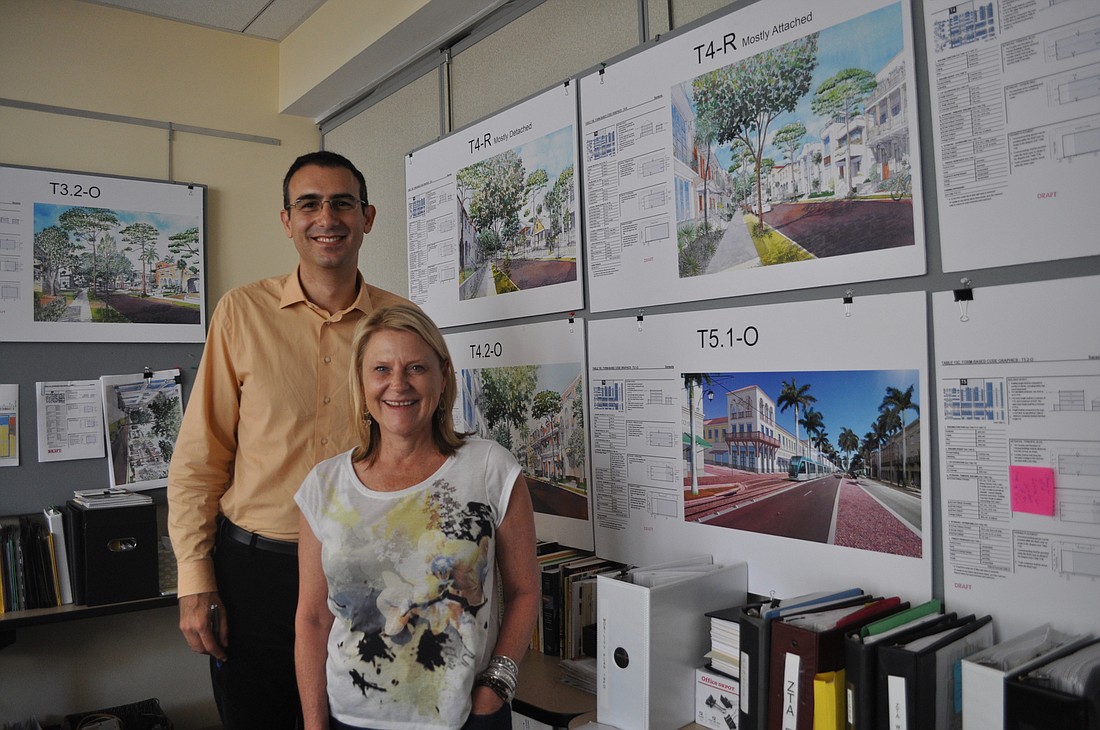- May 3, 2024
-
-
Loading

Loading

As he walks you through the thinking that’s guided his past five months of work, it’s clear Andrew Georgiadis knows the idea of establishing architectural standards is controversial in Sarasota.
“It’s not meant to limit architects and their craft,” Georgiadis said. “It’s a vehicle to get greater freedoms.”
Georgiadis, originally hired as a member of the city’s Urban Design Studio in 2013, has been focusing on these architectural standards under the supervision of city staff since June. The hope is to incorporate these standards in the forthcoming form-based zoning code, the new bible governing development in Sarasota.
He believes he’s crafted the blueprint for a reasonable document, working alongside local architects to determine what they like and don’t like about the existing code.
Still, he hasn’t been able to satisfy all the doubters. And so, he’s appealing to the architect community as he explains the standards he’s written. It’s a market-based solution, he says repeatedly. It allows architects to do things they’re not allowed to do currently, as long as they meet certain requirements in return.
“It would be oversimplifying the world to say, ‘We want all those other freedoms, and we don’t want a single sentence about the quality of the architecture,’” Georgiadis said.
He’s optimistic that skeptics can be won over, but the fate of the document he’s created is beyond his control. Georgiadis submitted his resignation to the city in September, with his final day set for Oct. 23. He’s worked apart from Karin Murphy, the director of the Urban Design Studio and his former partner in crafting the code.
“I don’t know how it will be grafted onto the work of others,” Georgiadis said of the standards.
As architects, city staff and Murphy prepare to examine Georgiadis’ work, the question of how the architectural standards will be incorporated into the code remains mostly unanswered.
There is no single definition of what “architectural standards” look like. Murphy said that Miami’s code doesn’t have any architectural standards, though the code she and Georgiadis developed for downtown Bradenton does.
Here’s the gist: These regulations would govern how a building looks and sits on the street. It comes with greater specificity than other regulations — hence the concern for some architects.
“By being much more prescriptive about what you can and cannot do, the fear is that it’s not going to only restrict creativity — that’s probably the number one fear — but also that it’s going to create some level of same-ness,” said Jonathan Parks, an architect with Solstice Architects.
That fear might be fueled by the architectural standards present in Sarasota’s downtown zoning code, approved in 2004. Parks said architects worry prescriptive standards might encourage one style over another — and Georgiadis believes the downtown code includes some regulations favoring traditional structures.
"The fear is that it’s not going to only restrict creativity — that’s probably the number one fear — but also that it’s going to create some level of same-ness." — Jonathan Parks
He’s worked to address those issues, including provisions for multiple styles. Once Georgiadis leaves the city, the Gulf Coast chapter of the American Institute of Architects will work with the city to further develop the architectural standards.
Murphy believes Georgiadis’ draft needs a thorough community vetting. She recommended a revision of those two chapters — the first of which deals with building form and the second with architectural standards.
“This would give us a reset, if you will, on that portion of the code,” Murphy wrote in an email to Gulf Coast AIA President Lisa Hess.
Murphy isn’t opposed to implementing architectural standards. Still, she welcomes criticism from architects as the city works to develop crucial elements of that portion of the code.
Hess said she was appreciative of the effort to get the architectural community’s feedback. She’s still waiting to see specifics regarding the architectural standards, but said the broader concern relates to establishing specifics in a subjective medium.
“What defines a better building?” Hess said. “What defines ‘good design?’”
Both Murphy and Georgiadis declined to comment on the specifics of their split this summer. City Manager Tom Barwin acknowledged that Murphy’s experience developing the downtown code might color her outlook on architectural standards.
“It’s why maybe she’s been a little more cautionary on some of these initiatives, because she’s probably lived through versions of some of this once or twice before,” Barwin said.
Barwin talks about architectural standards in a different way than Georgiadis, speaking philosophically about the need to inspire architects to create outstanding projects.
"It seems like a logical thing to do, with the environment that we’re blessed with in terms of what Mother Nature has provided." — Tom Barwin
“It seems like a logical thing to do, with the environment that we’re blessed with in terms of what Mother Nature has provided,” Barwin said.
He’s been a leading advocate for the implementation of architectural standards, having worked in two communities that imposed similar regulations. In both places, Barwin said, the additional regulations led to improvements.
He, too, invites feedback from the architectural community over the next six months. He’s hopeful that Georgiadis’ work can be translated into architectural standards that help produce a higher overall quality of building in Sarasota, but he wants architects to rest assured that nothing is finalized yet.
“I’d say everybody keep their powder dry, and let’s go through the conversation,” Barwin said. “We’re anxious to hear what it is the community can do, if anything, to have buildings contribute to the betterment of the community to as great a degree as possible.”